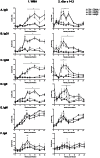Antibody responses to Sarcoptes scabiei apolipoprotein in a porcine model: relevance to immunodiagnosis of recent infection
- PMID: 23762351
- PMCID: PMC3675102
- DOI: 10.1371/journal.pone.0065354
Antibody responses to Sarcoptes scabiei apolipoprotein in a porcine model: relevance to immunodiagnosis of recent infection
Abstract
No commercial immunodiagnostic tests for human scabies are currently available, and existing animal tests are not sufficiently sensitive. The recombinant Sarcoptes scabiei apolipoprotein antigen Sar s 14.3 is a promising immunodiagnostic, eliciting high levels of IgE and IgG in infected people. Limited data are available regarding the temporal development of antibodies to Sar s 14.3, an issue of relevance in terms of immunodiagnosis. We utilised a porcine model to prospectively compare specific antibody responses to a primary infestation by ELISA, to Sar s 14.3 and to S. scabiei whole mite antigen extract (WMA). Differences in the antibody profile between antigens were apparent, with Sar s 14.3 responses detected earlier, and declining significantly after peak infestation compared to WMA. Both antigens resulted in >90% diagnostic sensitivity from weeks 8-16 post infestation. These data provide important information on the temporal development of humoral immune responses in scabies and further supports the development of recombinant antigen based immunodiagnostic tests for recent scabies infestations.
Conflict of interest statement
Figures




References
-
- Pence DB, Ueckermann E (2002) Sarcoptic mange in wildlife. Rev Sci Tech Off Int Epiz 21: 385–398. - PubMed
-
- McDonald M, Currie BJ, Carapetis JR (2004) Acute rheumatic fever: a chink in the chain that links the heart to the throat? Lancet Infect Dis 4: 240–245. - PubMed
-
- Sarasa M, Serrano E, Soriguer RC, Granados JE, Fandos P, et al. (2011) Negative effect of the arthropod parasite, Sarcoptes scabiei, on testes mass in the Iberian ibex, Capra pyrenaica . Vet Parasitol 175: 306–312. - PubMed
-
- Pence DB, Windberg LA (1994) Impact of a sarcoptic mange epizootic on a coyote population. J Wild Man 58: 624–633.
Publication types
MeSH terms
Substances
Grants and funding
LinkOut - more resources
Full Text Sources
Other Literature Sources
Medical
Miscellaneous

